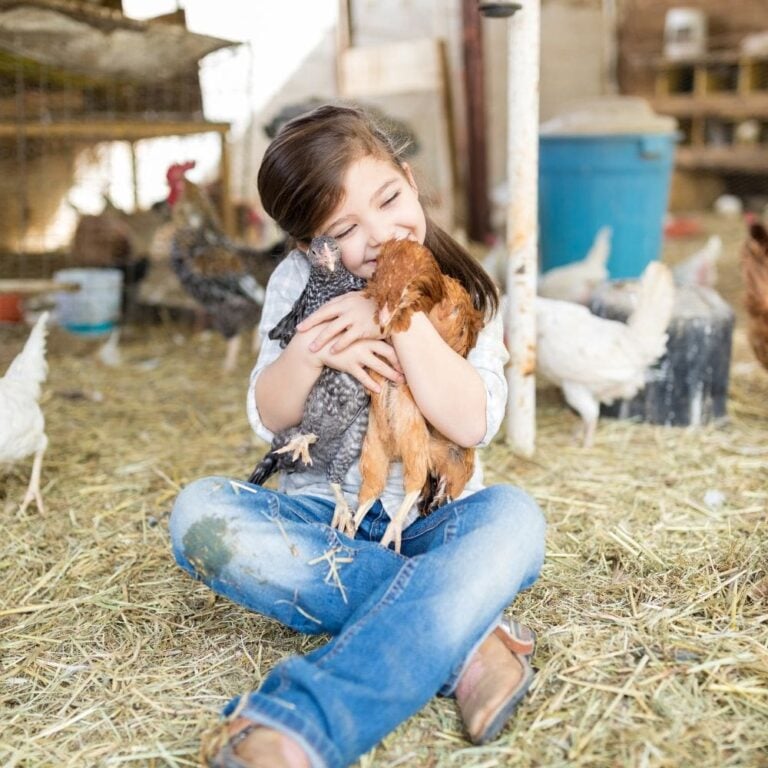Table of Contents (Quickly Jump To Information)
This session, I answer your questions about chickens in winter, broody hens, and covered runs.
So, this podcast on What The Cluck?! is a bit different – I’m answering your questions about chickens.
(If you’re interested in raising hens for eggs and meat, I can help! Check out my new book, Chickens: Naturally Raising A Sustainable Flock on Amazon!)
For the past couple months, I’ve been wanting to make What The Cluck?! a more frequent podcast, and I’m ashamed that I hadn’t thought of making a second weekly episode about answering your questions.
I’m soooo glad to announce that this will be a weekly thing, along with the Friday topic discussions, so please DO send me your questions.
READ NEXT: HOW TO BUILD A CHICKEN COOP (WITHOUT BREAKING THE BANK)
You can email them to me at editor@thefrugalchicken.com or contact me on one of my other social media channels.
I can’t wait to hear them.
So, this week, I answer questions about chickens staying warm in winter, broody hens, and covered runs.
You’ll learn:
- When you really need to be concerned about chickens in cold weather
- Why you shouldn’t move a broody hen (even if the other chickens are squawking about wanting to use her nesting spot)
- Why you shouldn’t skimp on covering your flock’s run
Links we discuss
TheFrugalChicken.com/TheBetterEgg
LIKE THIS PODCAST? LISTEN TO THEM ALL HERE!
Transcript
Hi there, and welcome to session 20 of What the Cluck?!, a podcast devoted to keeping chickens for fun and self-sufficiency. I’m Maat from FrugalChicken.
Now, we’re doing something a little different than our normal format.
For a while now, I’ve been wanting to move What The Cluck?! into a more frequent format, so once a week now, I’m going to start taking questions from you guys about chickens.
I’m a little embarrassed that I didn’t think of this sooner, but better late than never.
So, today I’m answering 3 questions about chickens.
And as a reminder, you can get this podcasts show notes at TheFrugalChicken.com/Podcast20, that’s podcast two zero.
The first one is about how chickens stay warm in winter, the second is about whether to move a broody hen, and the third is about whether chicken runs, not coops but their runs, should have roofs.
Now, if you want to submit a question, you can reach out to me over Twitter, you can find me at TheFrugalChicken.com/Twitter, or you can email me at editor@thefrugalchicken.com to submit a question.
And I do look forward to receiving them.
So, let’s get into today’s episodes.
READ NEXT: 7 WAYS TO USE CHICKENS IN YOUR GARDEN
The first question is:
How do chickens stay warm in the winter if it is freezing outside? My chicken book says they will be ok, but is there something else I need to do?
No, they will likely be fine.
The exception is if you live where it’s very cold, for example, negative 20 or 30 degrees, then you might need to supplement with a heat source.
It’s always best to avoid this if possible because red infrared lamps just get too hot and might cause a fire.
If you like, you can use shavings or extra straw in their coop to give them a warm place to stand, but generally speaking, in most areas of the United States, chickens will do perfectly fine in the winter.
So how do they stay warm?
Chickens stay warm by fluffing their feathers, it’s their natural way of keeping their body temperature regulated. So, it keeps them warm in the winter and cool in the summer.
Remember that during the day, chickens will move around, they’ll walk around as they forage for food, so they’re able to keep warm that way too.
At night, they keep their feet warm by resting their bodies on them as they roost.
Another reason to avoid a heat source in the coop, is if the coop is too warm, then when they step outside, they experience a drastic temperature change, which isn’t good.
So, if you do want to provide a heat source, heating the coop to about 35 degrees or so will suffice, but like I said, in most areas of the US, this isn’t necessary.
Should you have laying chickens in a different area then where you hatching chickens with broody gals?
So, to answer this question, no, not necessarily.
While it’s a nice idea, I don’t think it’s really required. Broody hens can be very assertive when they want to be, so if you’re concerned that other hens will interfere with her or cause problems, the broody hen can probably take care of herself.
My hens like to share the same nesting boxes, as I think most people’s hens do, and when one hen wants to use the box, the others can’t really stop her.
So, a broody hen will make it known, in my opinion. That the nesting box is hers. (Here’s how to incubate chicken eggs.)
READ NEXT: HOW TO HATCH CHICKEN EGGS
The other chickens might lay eggs in the box while the broody hen is in it, but this is not likely to disturb the broody one.
By moving her or walling her off in some way, you’re creating extra work for yourself, and it’s really not necessary.
You will have to provide extra food and water for her, which you wouldn’t have to do otherwise.
The layers will find another place to hang out, and do their business.
The other thing is that hens are social animals, and moving broody chickens or otherwise barring her from interacting with her flock might cause more stress than necessary.
Should we put a roof over their run so it stays dry?
While this isn’t completely necessary, in my opinion, yes. There’s a few reasons for this.
In their run, obviously, chickens poop, and eventually, unless you move them in a tractor for example, they will quickly turn a grassy run into dirt.
When it rains, their poop and everything mixes with the dirt, making a muddy soup of disgusting stuff. It smells, it’s unhygienic, etc.
Even if you use something like straw or shavings in their run, when it rains, it produces muck.
Another issue is although chickens can easily handle getting wet in most weather, in the winter, if they get wet, that can lead to some pretty big issues.
Freezing rain, especially, more than snow, is a big issue in winter because the chickens get wet, and it’s really cold, and it’s just not good.
A tarp or some sort of roof over their run will help keep them dry and better able to withstand the cold.
Now another issue, and this can come in any season, is if their coop is wet, meaning the ground is full of poopy mud, then remember that your chickens will try to eat off it.
So, chickens aren’t really that discerning, so if there’s something good to eat on the ground, they will go for it. If their food gets on the ground, regardless of ground conditions, they’re still going to go after it.
Then you run into issues of your chickens eating manure they just eliminated, and putting bad bacteria back into their bodies and you get the point. So, some sort of cover will help avoid that issue.
When it comes to a roof, really anything will do, we’ve used tin, tarps, awnings, anything that will keep the area dry and that can withstand high winds or snow covering it will work.
You’ll need to make sure there’s enough support, for example, with awnings and tarps, water can easily collect, causing the entire roof to cave in. So, just be prepared to address that as an issue.
READ NEXT: 8 WAYS TO SAVE MEGA BUCKS ON CHICKEN FEED
So that’s it for today’s episode. Again, I would love it if you submitted a question to me.
As a reminder, you can tweet me at TheFrugalChicken.com/Twitter or email me at editor@thefrugalchicken.com.
You can also reach out to me through any of my other social media channels, of course.
Now, if you’re interested in learning about the one thing you should feed your chickens for better eggs, then you can grab my free ebook The Better Egg at TheFrugalChicken.com/TheBetterEgg.
Thanks for listening to this episode of What The Cluck?! and I’ll see you next time!
Maat van Uitert is a backyard chicken and sustainable living expert. She is also the author of Chickens: Naturally Raising A Sustainable Flock, which was a best seller in it’s Amazon category. Maat has been featured on NBC, CBS, AOL Finance, Community Chickens, the Huffington Post, Chickens magazine, Backyard Poultry, and Countryside Magazine. She lives on her farm in Southeast Missouri with her husband, two children, and about a million chickens and ducks. You can follow Maat on Facebook here and Instagram here.







